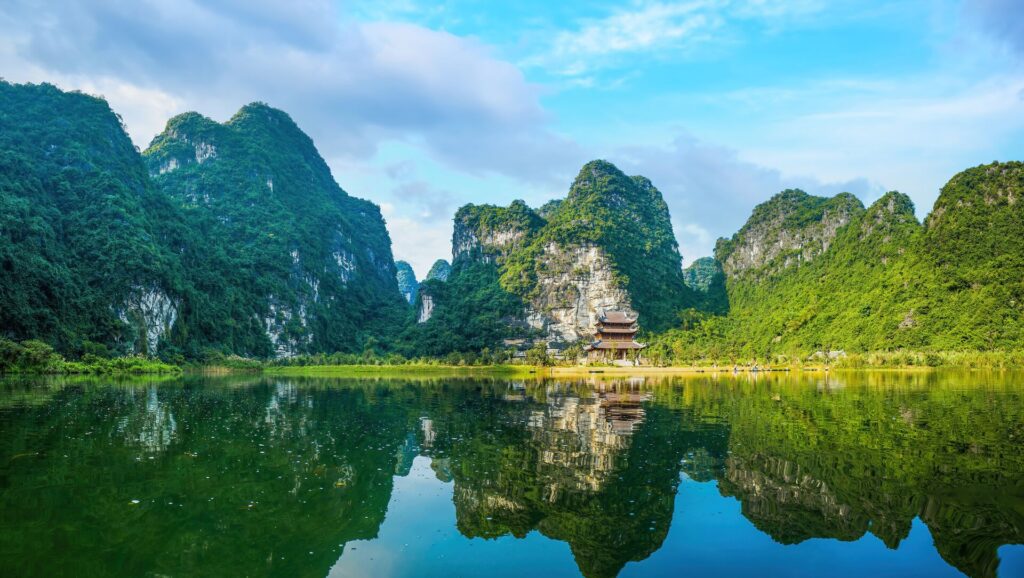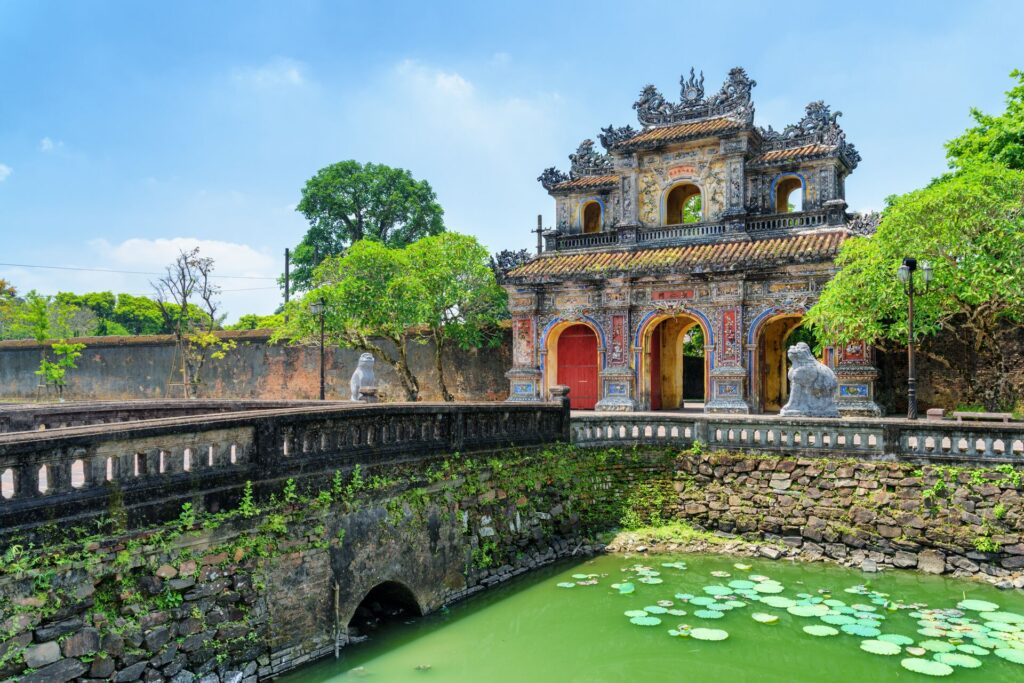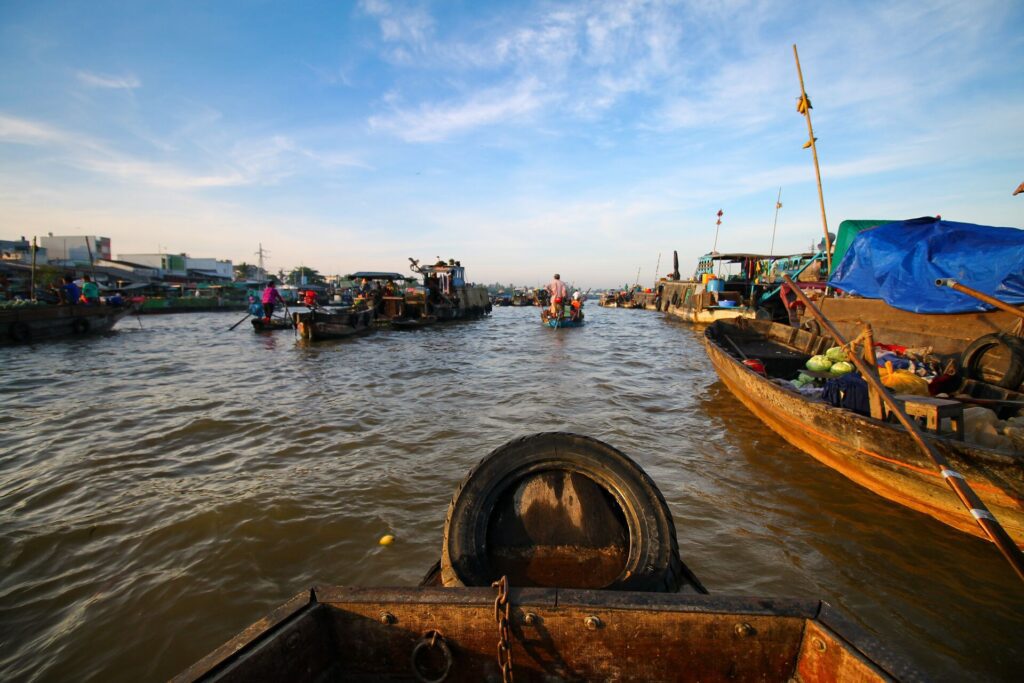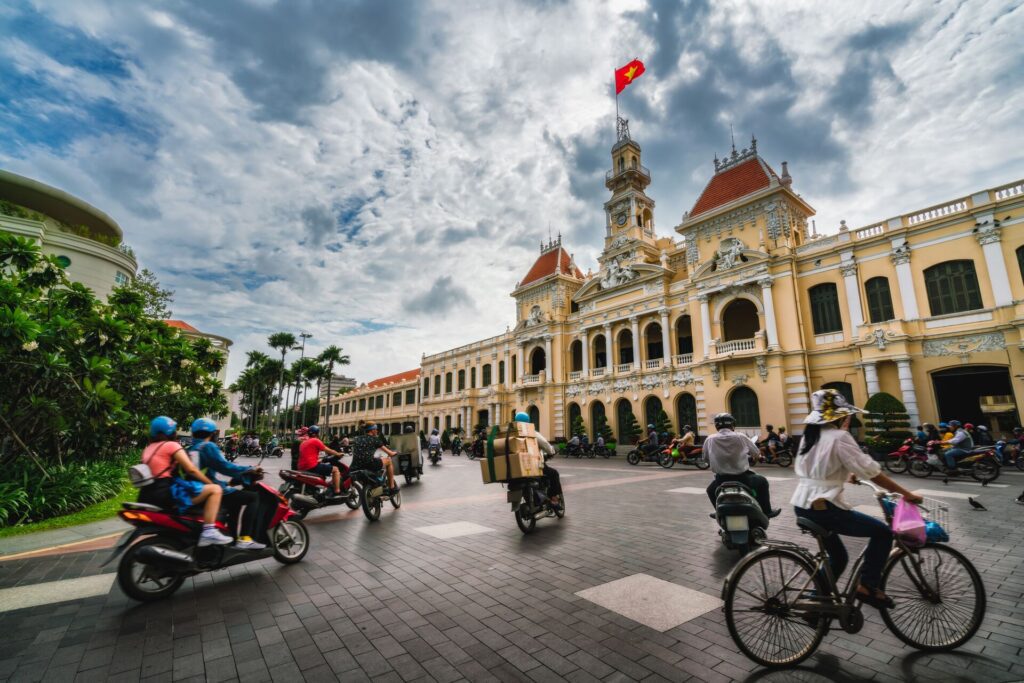From charming highland villages in the far north to tropical rivers and coral-fringed islands in the south, Vietnam stretches more than 1,650km along the eastern edge of mainland Southeast Asia, bordered by China, Laos and Cambodia. And while you can visit all year round, deciding when to travel to Vietnam depends on where you’re headed and what kind of experience you’re after (get your bearings with this handy map).
There are distinct wet and dry seasons across the country, but each region is shaped by more nuanced shifts in weather. In the northern towns of Sapa, Ha Giang and Hanoi, winter (December to February) is cool and often foggy, while summer (May to September) brings high heat and humidity. Spring (March to April) and autumn (October to November) are more temperate and generally drier. Along the central coast around Hoi An, Hue and Danang, autumn is typhoon season, while late spring and early summer are best for rolling out your beach towel. In the far south, from Ho Chi Minh City to the Mekong Delta, it stays warm year-round, but the wet season runs from May to November.
So, whether you’re seeking cultural adventures, wildlife encounters or delicious foodie experiences, it’s worth factoring these variable conditions into your holiday plans – and you can use this Vietnam travel guide to do just that.


Quick Summary: Best Times to Visit Vietnam
Deciding when to travel to Vietnam mostly depends on what you want to do, whether you’re looking for a laidback escape to nature, an authentic cultural adventure fizzing with energy, or something memorable in between. Get started with this snapshot:
For Beaches
The central coast – around Hoi An, Danang and Hue – is usually at its most beach-worthy from April to July, when it’s warm, dry and sunny. For southern islands like Phu Quoc, Con Dao and the Mekong Delta coast, plan your trip during the dry season from December to April.
For Cities and Culture
Cultural hotspots like Hanoi, Hue and Ho Chi Minh City are at their best between March and May, or October and November, when temperatures are more moderate and there’s less rain. For a deeper cultural dive, time your visit with Tet (Vietnamese Lunar New Year, usually January or February) or the Mid-Autumn Festival (September or October) – both vibrant nationwide celebrations with colourful parades, traditional performances and community get-togethers.
To Avoid Crowds
Vietnam’s busiest periods are during Tet and the domestic summer holidays (July to early September), when travel peaks around popular beach towns and heritage sites. Time your visit for the shoulder months – May to early June or late September to early December – when the weather is still comfortable in most regions, but you won’t need to sidestep the throngs at key attractions.
Our 13-day fully customisable Authentic Vietnam journey showcases Vietnam’s rich culture, cuisine, and wildlife from Hanoi to Halong Bay, Hoi An, Hue, and vibrant Ho Chi Minh City.


Vietnam’s Climate by Region
Vietnam’s key regions experience distinct seasonal patterns. Here’s how that looks:
Northern Vietnam (Hanoi, Sapa, Ha Giang)
Travellers are drawn to the north for its mountain treks, vibrant ethnic cultures, French-influenced capital (Hanoi), UNESCO-listed Halong Bay, ancient Thang Long, and Animals Asia’s Tam Dao Bear Sanctuary. Spring (March to April) and autumn (October to November) are generally mild and dry, while summer (May to September) is hot, humid and rainy, with the wettest months being July and August. Winters (December to February) can be cold and misty, especially in the highlands around Sapa and Ha Giang. The region’s annual average temperature ranges from 17°C in winter to 29°C in summer, with rainfall roughly 1,800-2,000mm per year. Typhoons can affect the area between August and October, while summer monsoons can cause floods and landslides.
Central Vietnam (Hoi An, Hue, Danang)
This stretch of coast is known for its golden beaches, imperial history and charming towns, with its hitlist of highlights headlined by the UNESCO-listed Hoi An Ancient Town, the Complex of Hue Monuments, seaside Danang, and its thriving culinary scene (read our story What to Eat in Vietnam for a taste of its unmissable dishes). The weather here is more volatile than in other regions. The dry season usually runs from February to July, with hot, sunny days peaking in June and July, while the wet season lasts from August to January, with particularly intense rains in October and November. This is also when the region is most vulnerable to typhoons and flooding. Temperatures range from about 19°C in winter to 34°C in summer, with annual rainfall of 2,500-3,000mm.


Southern Vietnam (Ho Chi Minh City, Mekong Delta)
Southern Vietnam is a treasure trove of cultural highlights, including Ho Chi Minh City’s colonial landmarks, the mighty Mekong River and its lush Delta. This region has a true tropical monsoon climate, with a dry season from December to April, and a wet season from May to November. Rain is most intense in June to September, and humidity peaks in the lead-up to the rains, especially in April. Average temperatures remain reasonably stable year-round, ranging from 25°C in the coolest months to 35°C in the hottest, with annual rainfall of around 1,800-2,300mm. While typhoons are less common here, the south can still be affected by heavy inland flooding during strong storms.
Our 10-day Flavours of Vietnam journey serves a spread of authentic experiences, including everything from culinary classes to home-cooking tours and expert-led street-eats excursions.
Month-by-Month Travel Guide
Seasonal conditions vary widely across the country, so consider the following as you’re planning.
January to March
It’s winter in the north and dry season across most of the country. The south and central coast are warm, sunny and ideal for beach breaks, while northern Vietnam is cooler and mistier – great for mountain excursions and culture-focused city breaks. Tet usually falls in late January or early February and is not only Vietnam’s biggest public holiday but also a busy time for domestic travel, with festivities usually lasting for between 7 and 9 days. Typhoons are rare in this period, but the far north can feel chilly, occasionally dipping below 10°C in places like Sapa. This is an excellent time to head to Phu Quoc, Hoi An or the Mekong Delta, where the weather is clear and bright, and the landscapes lush.


April to June
This is late in the dry season across much of the country and the shoulder season for international visitors. Central Vietnam is at its best, with warm, dry days ripe for exploring Hue, Hoi An or Danang’s beaches. The north starts to heat up and the south becomes more humid, with the first summer rains typically falling in late May. Not a fan of humidity? Avoid the Mekong in June and consider the central coast your sweet spot for weather and lower tourist numbers.
July to September
This is the wet season and peak monsoon in the north and south, so you can expect regular downpours, high humidity and the greatest risk of flooding and travel disruptions. Typhoons can affect the central coast from August, especially around Hue and Hoi An. Domestic school holidays mean July and August are busy times in popular resort areas, and temperatures remain high nationwide – often over 35°C – with the central highlands and mountainous north significantly cooler. It’s a good time to visit Ha Giang or Tam Dao for scenic sightseeing, bear conservation experiences, and trekking adventures away from the crowds.
October to December
It’s peak autumn in the north and the start of the dry season in the south. October and November are excellent for hiking in Sapa or Ha Giang, with crisp air and clear views. Hanoi is very popular with international visitors thanks to its bright, mild conditions, while Hoi An becomes more appealing by late November as the rains start easing. The Mekong Delta and Ho Chi Minh City begin to dry out and cool slightly, with November especially good for Mekong cruises as the river’s levels are high, humidity is lower, and village life is in full swing. On the flip side, the central coast often sees intense rainfall in this period.
Enjoy nine extraordinary days exploring the north’s iconic highlights by boat, bike, immersive hikes and flavourful bites on our Authentic North Vietnam holiday.


Typhoon and Rainy Season: What to Expect
The rainy season typically runs from May to October in the north and south, and from August to January along the central coastline. Generally, temperatures remain above 25°C in most regions and rainstorms don’t clear away the humidity (in fact they often increase it). In the wettest regions, like Hue, up to 100mm of rain can fall in a single hour during peak downpours, according to Vietnam’s Meteorological and Hydrological Administration.
Typhoons are most likely between August and October, especially in the central and northern regions, and can cause transport delays and sometimes flooding – but such extreme events don’t happen every day. Most wet-season travellers will experience short, heavy showers lasting one to three hours, usually in the afternoon or evening, rather than a nonstop downpour.
To be prepared, carry a light rain jacket or poncho, weatherproof your bags, and keep your itinerary as flexible as possible, especially if you’re travelling overland: during storms, the roads in remote areas may temporarily close, and ferries may be paused. Your best bet is to check the local weather forecasts before continuing onto the next stage of your wet-season adventure.
Our 4-day Animals Asia Bear Sanctuary Visit takes in the best of Hanoi and Makes Travel Matter with exclusive experiences at the Tam Dao Bear Sanctuary and KOTO’s social-enterprise restaurant.
When Not to Visit Vietnam – and Why
Vietnam is worth visiting all year round, but to ensure you can comfortably explore as far and wide as possible, it might be best to rethink travelling between late July and early September. In July-August, local school holidays see a surge in domestic tourism. This is also when the monsoon season peaks in the north and south, so there’s the potential for heavy rains and flooding to disrupt your travel plans (in fact, according to the Vietnam’s Meteorological and Hydrological Administration, the wet season accounts for up to 90 per cent of the country’s annual rainfall). In the central regions, heat and humidity can make sightseeing uncomfortable, while along the central and north coasts, August and September are the peak months of the June-November typhoon season, which can quite literally put a damper on your travel plans.
Explore the rich histories, natural beauty and vibrant cultures of Vietnam, Laos and Cambodia on Adventure World’s 17-day Authentic Indochina journey.
Final Tips for Planning Your Trip
All in all, the best time to visit Vietnam depends on the type of holiday you have in mind. For blue-sky days and easy beach breaks, the central coast shines from April to July, while the southern islands and Mekong Delta are at their best from December to April. Prefer trekking or exploring cultural hubs? Northern Vietnam is ideal in spring or autumn, when conditions are clear and mild. And provided you pack smart and stay flexible, the wet season isn’t off-limits either – it’s when landscapes are at their lushest and crowds are at their thinnest. But whatever your priorities, Vietnam’s three regions offer stellar adventures all year round – now you just need to decide which season best suits you.
